History of the Omega Seamaster and a guide to its successive models
Click here to watch a video showcasing the charms of the Omega Seamaster series.
When you look at an Omega Seamaster, you will see various numbers after the word "seamaster."
And while one might think that this number means it is waterproof, this is not actually the case.
How did this confusion come about?
This becomes clear when we look into the history of the Seamaster.
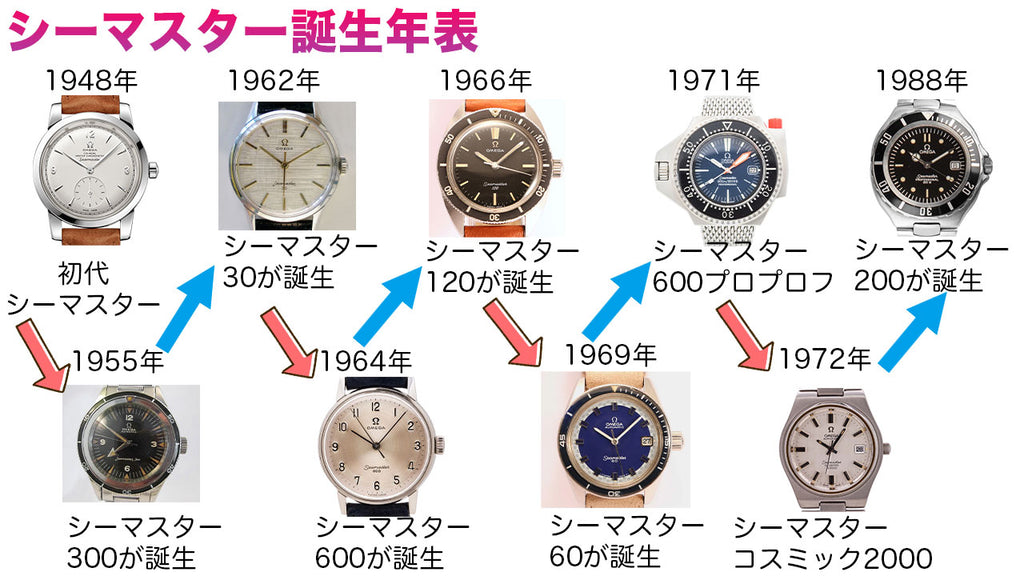
First of all, I want you to listen to this, so I will explain the most important thing first.
・Seamaster 30 = a model equipped with a 30mm caliber
・Seamaster 60 = 60M water resistance
・Seamaster 120 = 120M water resistance
・Seamaster 200 = 200M water resistance
・Seamaster 600 = Model equipped with Caliber 600 series
・Seamaster 600 ProProf = 600M water resistant
・Seamaster 6000 Planet Ocean = 600M water resistant
・Seamaster 1000 Professional = 1000M water resistant
・Seamaster Cosmic 2000 = Just a model name
In short, it gets confusing because there is a mixture of numbers that directly indicate waterproofing and numbers that indicate other things.
In today's article, I will explain the appeal of each of these complicated Seamaster models in order of their birth years, so by the time you finish reading this article, I think you will have an 80% understanding of the Seamaster, so please read to the end.
So let's get started right away.
The Birth of the Omega Seamaster
When we think of the Seamaster, we think of a serious model for professional divers, but the first Seamaster to come out was a regular watch equipped with waterproof functionality.
The first model was released in 1948, and it looked similar to the Constellation shown in this catalogue today.
The background to this is the Dirty Dozen Omega watches.
First of all, the requirement for waterproofing was a request from the British Army, and the waterproofing function was later trickled down to civilians and was installed on the Seamaster.
It feels like a luxurious version of the Dirty Dozen delivered to the British Army with a white dial.
Therefore, it was initially marketed as an all-round model that could be worn anywhere - in the city, at the beach, or in the suburbs.
The first Seamaster was released as a standard model with a center second hand, and as a chronometer model with a small second hand.
Therefore, although it does have a waterproof function, in 1954 it was found to be "waterproof to 60 meters" when tested by the Swiss Watch Institute.
That said, 60m water resistance is enough.
At this time, there was no number after Seamaster.
The Seamaster 300, a full-fledged diver's model, was then born in 1955.
1955: The Seamaster 300 is born

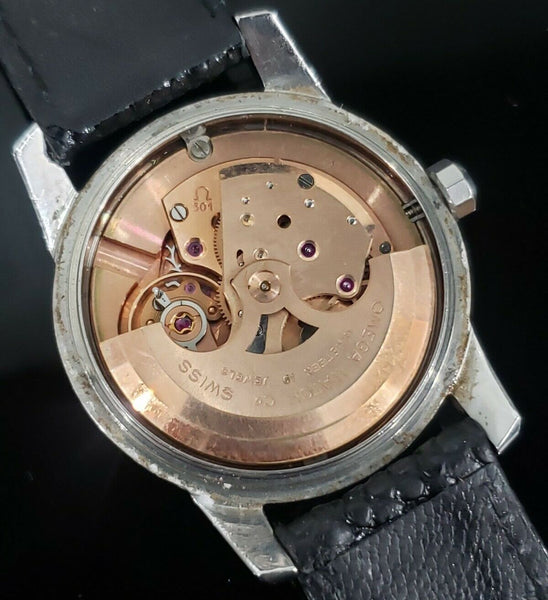
* Seamaster 300 Ref. 2913 movement Cal. 501
In 1953, Blancpain introduced the world's first diver's watch, the Fifty Fathoms, and the following year Rolex introduced the Submariner, highlighting the need for watches that could withstand prolonged underwater use.
Omega, renowned for its precision and technical prowess, was somewhat behind in this new diver's category and had to develop an entirely new watch specifically designed for professional use underwater.
It was not until 1957, two years after its release, that the Seamaster 300 was actually released as a professional diver's watch.
The first reference of the Seamaster 300 was the CK2913, equipped with the automatic caliber Cal. 501. Production continued until the mid-1970s, and it underwent several model changes.
The CK2913 alone has eight different variations, so we can't introduce them all here, but a distinctive feature is that the minute or hour hand is an arrow hand.
Following CK2913 comes ST14755.

The hands change to pencil hands and the seconds hand has an arrow pointer.
The movement is automatic Cal.552.
In 1964, the Seamaster 300 was introduced, a completely new design.
In the third generation, a model with and without a date display was born, the one without a date display is "Ref. 165.024".
With date display it will show " 166.024".

The Seamaster 300's case diameter increased from 39mm to 42mm, and its characteristic thin bezel was replaced with a thicker bezel with individual minute markings all around.
The needles also changed from pencil needles to large sword-shaped needles.
The third generation Omega Seamaster 300 was even more successful than the first, and held the honor of being the watch issued to Royal Navy personnel for several years.
Production of the third-generation Seamaster 300 continued until the mid-1970s, when Omega decided to discontinue production of the Seamaster 300 and instead produce other diving watches released within the Seamaster collection.
In 2014, Omega revived the Seamaster 300 name as the Seamaster 300 Master Co-Axial, a watch that is almost identical to the original 1957 Seamaster 300.
As such, the 300 from that time is now being reproduced, but this design is the origin of the Seamaster and can be said to be its greatest masterpiece.
For more information on the Seamaster 300, please see this article:
Omega Seamaster 300 CK2913: A Brief History and Collector's Guide
From here, we will introduce the Seamaster Collection models that were derived from it in chronological order.
1962: Seamaster 30 is born

The Seamaster 30 was introduced in 1962.
The "30" in the model name does not refer to the depth of water resistance, but to the size of the movement.
Omega's 30mm calibers proved extremely popular and began to be mass-produced in the mid-20th century.
The first Seamaster 30 was equipped with the calibre 286, which had a 42-hour power reserve and sweep seconds.
This is an evolution of Cal.30 and is a center second movement.
The overall aesthetic, with its thin bar indexes and clean, unadorned dial, is similar to other Omega dress watches, including the Constellation.
When the Seamaster 30 was first released, it was available as both a dress watch and a sports watch, but eventually the dress watch was discontinued and only the sports watch remained.
Early Seamasters are available in a variety of configurations, including time-only models as well as more complicated models with a date window at the 3 o'clock position.
Since the Seamaster 30 is made to be unbreakable from the time of manufacture, many of them are in good condition and can generally be purchased for less than 120,000 yen.
A black dial Seamaster sells for roughly double the price of its silver dial counterpart.
Even more so are the military watches of the Pakistan Air Force and the Royal Flying Sergeant Major General.

These watches feature indices reminiscent of the Railmaster and are highly rare.
These essential specifications are based on the WWW (Wristwatch Waterproof) watches issued to the British Army.
The Pakistan Air Force version has PAF (Pakistan Air Force) engraved on the back, and is the more commonly available version, but since they are still rare, they go for around 800,000 yen.
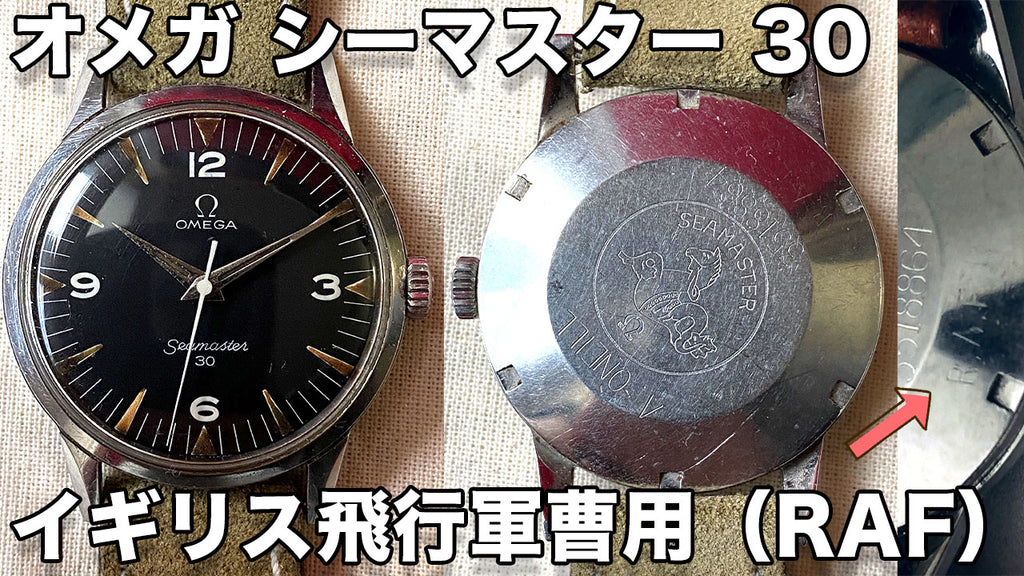
The other one is for a British Flight Sergeant. It was made for British Flight Sergeants stationed in Cyprus and Singapore and is stamped with the RAF (Royal Air Force), an individual number and the owner's name.
It may be a little hard to see from this image, but the part on the far right indicated by the red arrow has RFA engraved on it.
Prices are also unknown as sergeant watches rarely come on the market.
The Seamaster 30, with a basic model available for purchase for around 100,000 yen, offers overwhelmingly good value and cost performance when considered in terms of design, movement, and brand tradition.
The wide range of models, from simple time-only models to military models that were actually used, offers interesting options for everyone from beginners to niche collectors looking to expand their personal collections.
1964: The Seamaster 600 is born

The Seamaster 600 is named after the 30 for the same reason, it is not waterproof to 600m (although you can tell from the outside).
The movement used is the 600 series, and is equipped with Cal.601 and Cal.611.
1966: The Seamaster 120 is born

Following the success of the Seamaster 300, a professional diver's watch released in 1955, Omega designed a smaller model that was waterproof to 120m and released the Seamaster 120, which inherited the DNA of the larger model but was more affordable.
This Seamaster 120 comes with a cushion-shaped 37mm tonneau case as standard, but is also available in a boys' size of 31mm.

※ Omega Seamaster 120 37mm version
What's particularly noteworthy about the Seamaster 120 is that it was Omega's first diver's watch with a date display.
This was well received by consumers, and the date display was then adapted for other models.
One year after the introduction of the date display on the Seamaster 120, the function was also introduced on Omega's premium model, the Seamaster 300.
For more information on the Seamaster 120, please see this video:
1969: The Seamaster 60 is born

The Seamaster is water resistant to 60m, but there are models with and without the 60m rating, and it was produced in three different color variations: black, dark blue, and wine red.

This case was made by La Central Boite, one of Omega's favorite case makers in the 1960s, and is also the same case used for some Speedmaster watches.
The appeal of the Seamaster 60 is undoubtedly the "Big Crown".
This model is a beautiful diver's watch with a 37mm case, which is a modest size for a diver's watch but can be worn by most men.
Many of the other Seamasters were targeted at serious divers and so were larger and beefier in size to enhance their practical specifications.
On the other hand, although the Seamaster 60 is equipped with a big crown, it was not developed as a full-fledged diver's watch.
This model was developed as an ideal watch for snorkeling and moderate depth diving.
Omega therefore tested the watch to be waterproof to 60 meters, hence the name "Seamaster 60".
Compared to the Seamaster 120 and 300, the waterproof function is inferior.
However, what it lacks in performance is made up for by its design, and the distinctive oversized crown and plastic bezel give it a great deal of individuality.
At first, the crown may seem too large for the case, but the more you look at it, the more you realize how much of a visual impact it adds.
That's why it got the nickname "Big Crown".
It is fascinating how one seemingly simple element combines to have such a decisive impact on the overall aesthetic.
1971: Seamaster 600 Ploprof is born
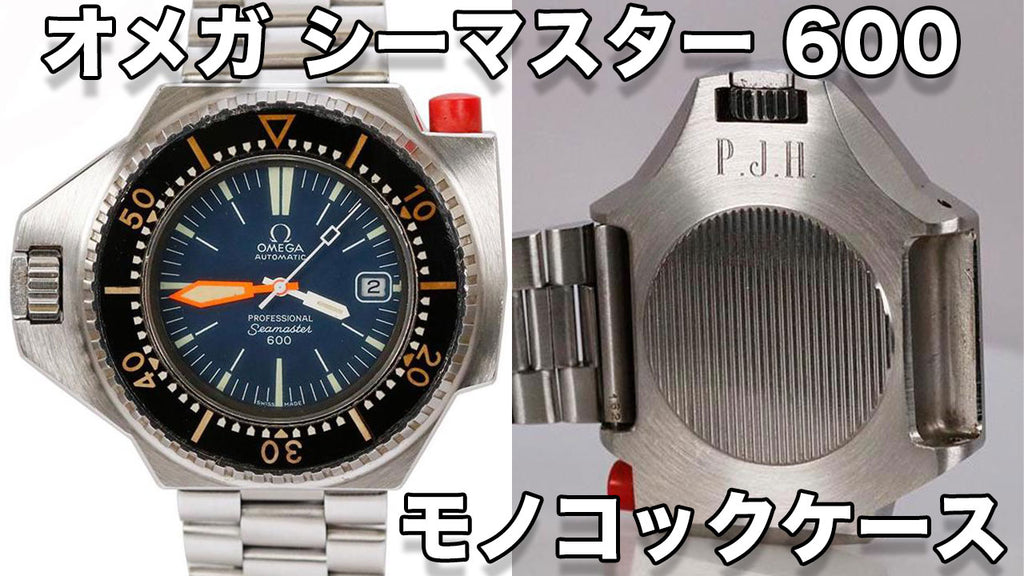
In the late 1960s, demand for underwater watches increased for applications such as underwater exploration, offshore oil drilling construction and maintenance, scuba diving, water sports, and Navy SEALs.
This was a time when private diving was booming and deep diving was becoming a hobby for ordinary people, especially in France.
So Omega developed a watch that was robust, waterproof, highly legible, reliable and suitable for deep water, and debuted it at the Basel Fair in 1969.
In fact, in 1970, divers from the private diver's company COMEX wore the watches on their wrists while they worked for a total of eight days, four hours a day. They are also famous for having been used during an offshore oil field survey conducted by Gulf Oil.
This time it was still a prototype, but the Seamaster 600 Ploprof was released for full retail sale in April 1971.
What sets it apart from other Seamasters is the inclusion of the word "Plongeur Professionnel," which means "professional diver."
Thus, while it was an excellent diver's watch for professionals, it also rode the trend of the time and gained great support in the retail market.
This model is Omega's first model to feature a monocoque case, with a crown on the left side of the case and a red push button on the right side to release the bezel's rotation prevention function.
This shape is the normal style, and although there is also an opposite version, this is for left-handed people.
The following year, the Seamaster 1000 Ploprof was born, which had even improved water resistance.
In this article, we will not discuss the Seamaster 1000 Ploprof.
1972: The Seamaster Ploprof 1000 is born
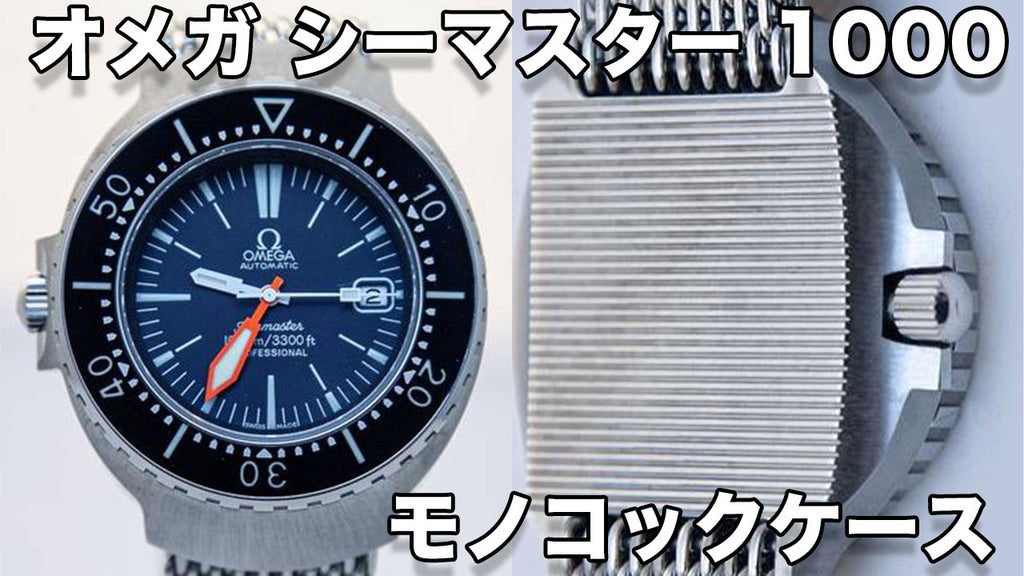
1988: The Seamaster 200 is born

This model is the predecessor to the current Seamaster 300 model, and is a retro model known among collectors as "Prebond."
There were many different model configurations available: quartz, steel and two-tone gold, automatic, mid-size and full-size, with black and champagne dials, Mercedes and baton hands.
It was produced from 1987 to 1995, but was essentially replaced by the Seamaster 300 Master Chronometer " Bond" Seamaster 300 in 1993.
Like many other Omega lines, the Seamaster 200 had its own event to highlight its deep sea credentials.
According to Omega's official website:
"On July 25, 1988, the French scientific submarine Nautile descended 4,400 metres below the surface of the Mid-Atlantic Ocean (a new record), taking part in the IFREMER Faré mission with a Seamaster Professional 200 Meter Calibre 1111."
It says:
Once again, the Omega Seamaster proved itself to be an essential watch for working at sea.
However, I personally think that the design of the Seamaster 200 is a bit questionable, so I will explain about another SHOM model.

While most previous models shared an oval case design, the SHOM does not follow that lineage, instead featuring a strongly angular case.
Although it is a derivative of the Seamaster 200, its design is completely different.
If we were to compare it to a car, the difference is so great that it would be equivalent to a full model change.
The case is made from a single piece of Swedish steel manufactured by EPSA, and the black dial features highly visible indexes, sword hands, and a depth reading of 200m/660ft.
The name comes from the French marine research institute SHOM (Service Hydrographique et Océanographique de la Marine/Naval Hydrographic and Oceanographic Service), a company that specializes in issuing official marine maps and nautical charts and was interested in diver's watches.
After exploring all the options and meeting certain requirements, SHOM approached OMEGA about the Seamaster 200.
As a result, it was decided to produce a model separate from the civilian 200 for official use, and the letters "SHOM" were engraved on the back so that it could be easily identified.
This model also caught the attention of the French military.
Having been selected by SHOM, its performance was recognized and the French Marine Corps also adopted this model as their official watch.
As a result, many more models were delivered as official watches for use with diver units.
As the watch is government certified, it bears the inscription "MN79" on the case back.
MN stands for Marine Nationale, which means the French Navy.
The number 79 was later engraved on the watch, marking the official commissioning date of the French Navy, making the Seamaster 200 even more famous.
And the Seamasters that came after this model are called Bond models, linked to James Bond from the 007 movies, and this leads to the Seamasters that we can buy new today.
summary
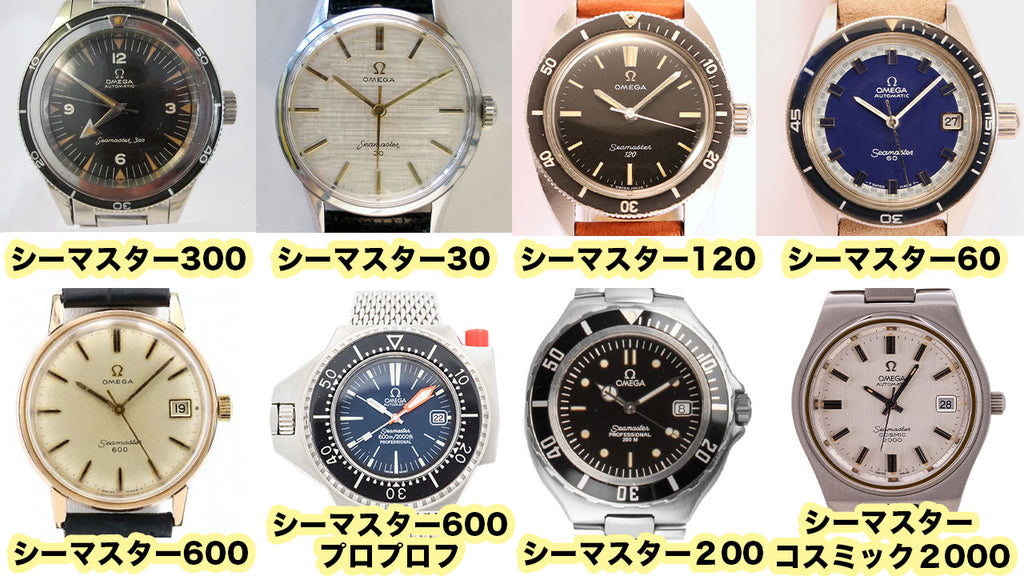
There are so many Seamaster series that it would get confusing to introduce them all, so in this article we have skipped the chronographs.
Although there are differences in waterproof performance, there are very few situations in which the waterproof performance of the Seamaster (as with other diver's watches) will be required.
Chances are, most of you reading this article aren't in that profession.
With that in mind, the good thing about vintage Seamasters is that you can get a standard model quite cheaply, and if you spend 500,000 to 700,000 yen you can choose a full-fledged diver model.
New watches are great, but when you look at vintage watches like this, the range of choices is greatly expanded.
I hope that this article will inspire those who currently own one to feel even more attached to it, and that those who are planning to buy one will be able to understand at least a little of its appeal.



